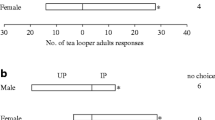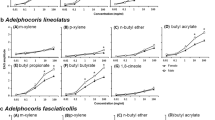Abstract
Plant volatiles are known to play a role in host location in many herbivorous insects. Although a few studies have determined the role of specific chemicals from herbivore-induced plant volatiles (HIPVs) in mediating interactions between conspecifics in insects belonging to Curculionidae, little is known about how this process works when different components are used. By measuring the behavioral responses of the tea weevil, Myllocerinus aurolineatus (Voss) (Coleoptera: Curculionidae), to a series of chemicals in a Y-tube olfactometer, we found that a blend containing (E/Z)-β-ocimene and (Z)-3-hexenyl acetate was attractive to male M. aurolineatus adults, and a blend containing 2-phenylethanol and (Z)-3-hexenyl acetate was attractive to female M. aurolineatus adults; both blends were as attractive to the insects as the volatiles emitted by the tea plants infested with adult weevils. A net cage experiment in the laboratory showed that traps baited with (E/Z)-β-ocimene plus (Z)-3-hexenyl acetate attracted the male herbivores, whereas the traps baited with 2-phenylethanol and (Z)-3-hexenyl acetate did not. Field experiments verified that tea plants exposed to a blend of (E/Z)-β-ocimene plus (Z)-3-hexenyl acetate attracted significantly more weevils than did the control plants or sticky traps baited with the above lure. These results suggest that the blend of (E/Z)-β-ocimene and (Z)-3-hexenyl acetate is an important signal which the tea weevil uses to locate its host, and is a strong candidate for an attractant that could be used to control the weevil.






Similar content being viewed by others
References
Birkett MA, Bruce TJA, Martin JL, Smart LE, Oakley J, Wadhams LJ (2004) Responses of female orange wheat blossom midge, Sitodiplosis mosellana, to wheat panicle volatiles. J Chem Ecol 7:1319–1328
Blight MM, Pickett JA, Smith MC, Wadhams LJ (1984) An aggregation pheromone of Sitona lineatus—identification and initial field studies. Naturwissenschaften 71:480
Bruce TJA, Wadhams LJ, Woodcock CM (2005) Insect host location: a volatile situation. Trends Plant Sci 10:269–274
Byers JA (1992) Attraction of bark beetles, Tomicus piniperda, Hylurgops palliatus, and Trypodendron domesticum and other insects to short-chain alcohols and monoterpenes. J Chem Ecol 18:2385–2402
Byers JA, Lanne BS, Löfqvist J, Schlyter F, Bergström G (1985) Olfactory recognition of host-tree susceptibility by pine shoot beetles. Naturwissenschaften 72:324–326
Byers JA, Zhang QH, Birgersson G (2000) Strategies of a bark beetle, Pityogenes bidentatus, in an olfactory landscape. Naturwissenschaften 87:503–507
Cha DH, Nojima S, Hesler SP, Zhang AJ, Linn CE, Roelofs WL, Loeb GM (2008) Identification and field evaluation of grape shoot volatiles attractive to female grape berry moth (Paralobesia viteana). J Chem Ecol 34:1180–1189
De Moraes CM, Mescher MC, Tumlinson JH (2001) Caterpillar-induced nocturnal plant volatiles repel conspecific females. Nature 410:577–580
Delphia CM, Mescher MC, De Moraes CM (2007) Induction of plant volatiles by herbivores with different feeding habits and the effects of induced defenses on host-plant selection by thrips. J Chem Ecol 33:997–1012
Deng JY, Wei HY, Huang YP, Du JW (2004) Enhancement of attraction to sex pheromones of Spodoptera exigua by volatile compounds produced by host plants. J Chem Ecol 10:2037–2045
Dicke M (1986) Volatile spider-mite pheromone and host-plant kairomone, involved in spaced-out gregariousness in the spider mite Tetranychus urticae. Physiol Entomol 11:251–262
Dickens JC (1989) Green leaf volatiles enhance aggregation pheromone of boll weevil, Anthonomus grandis. Entomol Exp Appl 52:191–203
Dickens JC, Smith JW, Light DM (1993) Green leaf volatiles enhance sex attractant pheromone of the tobacco budworm, Heliothis virescens (Lep.: Noctuidae). Chemoecology 4:175–177
Engelberth J, Alborn HT, Schmelz EA, Tumlinson JH (2004) Airborn signals prime plants against insect herbivore attack. Proc Nat Acad Sci USA 101:1781–1785
Farag MA, Fokar M, Abd H, Zhang HM, Allen RD, Paré PW (2005) (Z)-3-Hexenol induces defense genes and downstream metabolites in maize. Planta 220:900–909
Germinara GS, De Cristofaro A, Rotundo G (2008) Behavioral responses of adult Sitophilus granarius to individual cereal volatiles. J Chem Ecol 34:523–529
Giblin-Davis RM, Gries R, Crespi B, Robertson LN, Hara AH, Gries G, O’Brien CW, Pierce HD (2000) Aggregation pheromones of two geographical isolates of the New Guinea sugarcane weevil, Rhabdoscelus obscurus. J Chem Ecol 12:2763–2780
Heil M, Lion U, Boland W (2008) Defense-inducing volatiles: in search of the active motif. J Chem Ecol 34:601–604
Ibrahim MA, Nissinen A, Holopainen JK (2005) Response of Plutella xylostella and its parasitoid Cotesia plutellae to volatile compounds. J Chem Ecol 9:1969–1984
Innocenzi PJ, Hall DR, Cross JV (2001) Components of the male aggregation pheromone of strawberry blossom weevil, Anthonomus rubi Herbst. (Coleoptera: Curculionidae). J Chem Ecol 27:1203–1218
James DG (2003) Synthetic herbivore-induced plant volatiles as field attractants for beneficial insects. Environ Entomol 32:977–982
James DG (2005) Further field evaluation of synthetic herbivore-induced plant volatiles as attractants for beneficial insects. J Chem Ecol 3:481–495
Kännaste A, Nordenhem H, Nordlander G, Borg-Karlson AK (2009) Volatiles from a mite-infested spruce clone and their effects on pine weevil behavior. J Chem Ecol 35:1262–1271
Kost C, Heil M (2006) Herbivore-induced plant volatiles induce an indirect defence in neighbouring plants. J Ecol 94:619–628
Linn CE Jr, Dambroski H, Nojima S, Feder JL, Berlocher SH, Roelofs WL (2005) Variability in response specificity of apple, hawthorn, and flowering dogwood-infesting Rhagoletis flies to host fruit volatile blends: implications for sympatric host shifts. Entomol Exp App 116:55–64
McCall PJ, Turlings TCJ, Loughrin J, Proveaux AT, Tumlinson JH (1994) Herbivore-induced volatile emissions from cotton (Gossypium hirsutum L.) seedings. J Chem Ecol 12:3039–3050
Otálora-Luna F, Hammock JA, Alessandro RT, Lapointe SL, Dickens JC (2009) Discovery and characterization of chemical signals for citrus root weevil, Diaprepes abbreviatus. Arthropod-Plant Interact 3:63–73
Reddy GV, Guerrero A (2000) Behavioral responses of the diamondback moth, Plutella xylostella, to green leaf volatiles of Brassica oleracea subsp. capitata. J Agric Food Chem 48:6025–6029
Rodriguez-Saona C, Crafts-Brandner SJ, Paré PW, Henneberry TJ (2001) Exogenous methyl jasmonate induces volatile emission in cotton plants. J Chem Ecol 4:679–695
Ruiz-Montiel C, González-Hernández H, Leyva J, Llanderal-Cazares C, Cruz-López L, Rojas JC (2003) Evidence for a male-produced aggregation pheromone in Scyphophorus acupunctatue Gyllenhal (Coleoptera: Curculionidae). J Econ Entomol 4:1126–1131
Shimoda T (2010) A key volatile infochemical that elicits a strong olfactory response of the predatory mite Neoseiulus californicus, an important natural enemy of the two-spotted spider mite Tetranychus urticae. Exp Appl Acarol 50:9–22
Sun XL, Wang GC, Cai XM, Jin S, Gao Y, Chen ZM (2010) The tea weevil, Myllocerinus aurolineatus, is attracted to volatiles induced by conspecifics. J Chem Ecol 4:388–395
Szendrei Z, Averill A, Alborn H, Rodriguez-Saona C (2011) Identification and field evaluation of attractants for the cranberry weevil, Anthonomus musculus Say. J Chem Ecol 37:387–397
Tasin M, Bäckman AC, Coracini M, Casado D, Ioriatti C, Witzgall P (2007) Synergism and redundancy in a plant volatile blend attracting grapevine moth females. Phytochemistry 68:203–209
Toshova TB, Velchev DI, Subchev MA, Thóth M, Vuts J, Pickett JA, Dewhirst SY (2010) Electrophysiological responses and field attraction of the grey corn weevil, Tanymecus (Episomecus) dilaticollis Gyllenhal (Coleoptera: Curculionidae) to synthetic plant volatiles. Chemoecology 20:199–206
Weissling TJ, Giblin-Davis RM, Scheffrahn RH (1993) Laboratory and field evidence for male-produced aggregation pheromone in Rhynchophorus cruentatus (F.) (Coleoptera: Curculionidae). J Chem Ecol 19(6):1195–1203
Zhang QH, Ma JH, Yang QQ, Byers JA, Klein MG, Zhao FY, Luo YQ (2011) Olfactory and visual responses of the long-legged chafer Hoplia spectabilis Medvedev (Coleoptera: Scarabaeidae) in Qinghai province, China. Pest Manag Sci 67:162–169
Zhu JQ, Shang JN, Guo MM (1988) Study of the spatial distribution pattern and sampling technique of Myllocerinus aurolineatus Voss adults in the field. Entom Knowl 5:277–280
Zhu JW, Park KC, Baker TC (2003) Identification of odors from overripe mango that attract vinegar flies, Drosophila melanogaster. J Chem Ecol 29(4):899–909
Acknowledgments
We thank Emily Wheeler for editorial assistance. We thank Liqun Chen and Biao Gao, who came from Jilin Agricultural University and Yangtze University as summer students to our group, for collecting and rearing weevils. We thank Zongxiu Luo, who drew the draft of trap. The study was sponsored by National Program on Key Basic Research Project (973 Program) (2012CB114104), National Natural Science Foundation of China (31171862), the Division of Science and Technology of Zhejiang Province (2011C22043), and the Planning Subject of ‘the Twelfth Five-Year-Plan’ in National Science and Technology (2011BAD01B02-5).
Author information
Authors and Affiliations
Corresponding author
Rights and permissions
About this article
Cite this article
Sun, XL., Wang, GC., Gao, Y. et al. Screening and field evaluation of synthetic volatile blends attractive to adults of the tea weevil, Myllocerinus aurolineatus . Chemoecology 22, 229–237 (2012). https://doi.org/10.1007/s00049-012-0110-1
Received:
Accepted:
Published:
Issue Date:
DOI: https://doi.org/10.1007/s00049-012-0110-1




